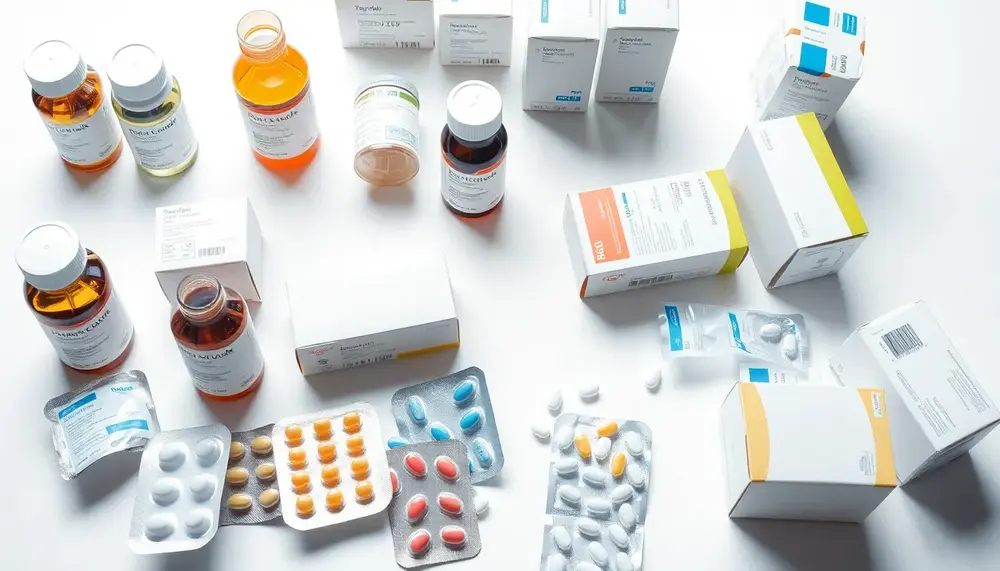Table of Contents:
Understanding the Importance of USP Standards in Pharmaceutical Packaging
Understanding the importance of USP standards in pharmaceutical packaging is crucial for ensuring the safety and efficacy of drug products. The U.S. Pharmacopeia (USP) sets forth guidelines that help manufacturers create packaging that not only protects the integrity of the medication but also complies with regulatory requirements.
One of the primary reasons USP standards are vital is their role in preventing contamination. Packaging materials can interact with the drug product, potentially leading to degradation or loss of potency. By adhering to USP standards, manufacturers can minimize these risks. This is particularly important for sensitive medications that may be affected by light, moisture, or temperature variations.
Moreover, USP standards provide a framework for evaluating the materials used in packaging. For instance, the guidelines specify testing for extractables and leachables, which are substances that can migrate from the packaging into the drug product. Understanding these interactions is essential for maintaining the quality of the pharmaceutical product throughout its shelf life.
Compliance with USP standards also fosters trust among healthcare professionals and patients. When a drug product is packaged according to recognized standards, it assures stakeholders that the product has been manufactured with care and meets safety requirements. This trust is critical in the healthcare sector, where the consequences of packaging failures can be severe.
In summary, the role of USP standards in pharmaceutical packaging cannot be overstated. They are essential for ensuring product quality, preventing contamination, and maintaining regulatory compliance. Manufacturers who prioritize these standards not only protect their products but also contribute to the overall safety and efficacy of healthcare solutions.
Applications of Plastic Packaging Systems in the Pharmaceutical Industry
Plastic packaging systems play a pivotal role in the pharmaceutical industry, serving a variety of applications that are essential for the safe and effective delivery of medications. These systems are designed not only to contain the drug products but also to protect them from environmental factors that could compromise their quality.
Some key applications of plastic packaging systems include:
- Blister Packs: Commonly used for tablets and capsules, blister packs provide a barrier against moisture and light, ensuring the stability of the medication until it is consumed.
- Vials and Ampoules: These containers are crucial for liquid medications, allowing for sterile storage and easy dispensing while minimizing contamination risks.
- Prefilled Syringes: Designed for injectable medications, prefilled syringes enhance convenience and accuracy in dosing, reducing the risk of dosing errors.
- Flexible Pouches: Often used for bulk pharmaceuticals, these pouches are lightweight and can be designed to be tamper-evident, providing additional security for the product.
- Dropper Bottles: Ideal for liquid formulations, dropper bottles allow for precise dosing and are commonly used for eye drops and other liquid medications.
- Caps and Closures: These components are critical for maintaining the integrity of the packaging system, preventing leakage and contamination.
In addition to these applications, the choice of materials used in plastic packaging is crucial. Commonly utilized materials include polyethylene, polypropylene, and polyvinyl chloride (PVC), each selected for their specific properties that enhance the performance of the packaging system.
Furthermore, the design of these packaging systems often incorporates features that facilitate patient compliance, such as easy-open mechanisms and clear labeling. This attention to usability not only improves the patient experience but also supports adherence to medication regimens.
In summary, the applications of plastic packaging systems in the pharmaceutical industry are diverse and critical. They ensure that medications are delivered safely and effectively, maintaining their quality and efficacy from production to patient use.
Benefits and Considerations of USP Standards in Pharmaceutical Packaging
| Pros | Cons |
|---|---|
| Ensures safety and efficacy of drug products. | Compliance can be costly for manufacturers. |
| Minimizes risks of contamination and degradation. | Requires ongoing monitoring and testing. |
| Enhances trust among healthcare professionals and patients. | May limit the use of innovative packaging materials. |
| Facilitates regulatory approval processes. | Standards may become outdated with new technologies. |
| Promotes consistent quality across products. | Intensive documentation and quality control required. |
Materials Used in Pharmaceutical Packaging: An Overview
In the pharmaceutical industry, the choice of materials for packaging is critical to ensure the safety, stability, and efficacy of drug products. Various materials are employed, each selected for their unique properties that cater to specific packaging needs.
Here’s an overview of commonly used materials in pharmaceutical packaging:
- Polyethylene (PE): This versatile plastic is widely used for its excellent moisture barrier properties. It is often found in flexible packaging, such as pouches and bags, and is suitable for a variety of drug formulations.
- Polypropylene (PP): Known for its high chemical resistance and durability, polypropylene is commonly used in containers, vials, and closures. Its clarity and strength make it ideal for packaging solid and liquid pharmaceuticals.
- Polyvinyl Chloride (PVC): PVC is frequently used in the production of blister packs and IV bags. Its ability to be molded into various shapes and forms allows for tailored packaging solutions, although it requires careful consideration regarding leachables.
- Polyethylene Terephthalate (PET): This material is favored for its excellent barrier properties against oxygen and moisture. PET is often used in bottles and containers for liquid medications, ensuring product integrity over time.
- Glass: While not a plastic, glass remains a popular choice for packaging pharmaceuticals, especially for injectables and sensitive formulations. Its inert nature prevents interaction with the drug, ensuring stability and safety.
- Blister Film: Composed of various polymers, blister films are designed to provide a protective barrier for tablets and capsules. They are engineered to prevent moisture and light from affecting the drug product.
Each material has its own set of advantages and limitations, which manufacturers must carefully evaluate based on the specific requirements of the drug product being packaged. Factors such as compatibility with the drug, potential for extractables and leachables, and regulatory compliance are all critical considerations in material selection.
In conclusion, understanding the materials used in pharmaceutical packaging is essential for ensuring that drug products are delivered safely and effectively to patients. The right choice of materials not only protects the integrity of the medication but also enhances patient compliance and satisfaction.
Quality Considerations in Pharmaceutical Packaging
Quality considerations in pharmaceutical packaging are paramount to ensure that drug products maintain their intended efficacy and safety throughout their shelf life. The integrity of the packaging system directly impacts the quality of the medication it contains, making it essential for manufacturers to prioritize various quality factors during the design and production processes.
One significant aspect of quality in pharmaceutical packaging is the compatibility of the packaging materials with the drug product. This compatibility must be assessed to prevent any adverse reactions that could compromise the drug's stability. Manufacturers often conduct extensive testing to evaluate how the packaging interacts with the drug, ensuring that no harmful substances are introduced.
Another critical consideration is the barrier properties of the packaging. Effective barriers against moisture, oxygen, and light are vital for preserving the chemical and physical stability of the drug. For instance, a packaging system that allows moisture ingress could lead to degradation of hygroscopic drugs, while exposure to light could affect photosensitive compounds. Therefore, selecting materials with appropriate barrier properties is essential.
Additionally, the manufacturing process of the packaging itself must adhere to stringent quality control measures. This includes ensuring that the production environment is clean and controlled to prevent contamination. Regular audits and inspections are necessary to maintain compliance with Good Manufacturing Practices (GMP) and other regulatory standards.
Furthermore, the potential for extractables and leachables must be thoroughly evaluated. Extractables are substances that can be extracted from packaging materials under specific conditions, while leachables are those that migrate into the drug product over time. Understanding and mitigating these risks is crucial for safeguarding the quality of the medication.
Finally, ongoing stability testing is essential to monitor the performance of the packaging over time. This testing helps identify any changes in the packaging that could affect the drug's quality, allowing manufacturers to take corrective actions as needed.
In summary, quality considerations in pharmaceutical packaging encompass material compatibility, barrier properties, manufacturing practices, and ongoing stability assessments. By addressing these factors, manufacturers can ensure that their packaging systems effectively protect the integrity of drug products, ultimately contributing to patient safety and therapeutic efficacy.
Understanding Extractables and Leachables in Packaging Materials
Understanding extractables and leachables (E&L) is essential in the context of pharmaceutical packaging, as these substances can significantly impact the safety and efficacy of drug products. Extractables refer to the compounds that can be extracted from packaging materials under specific laboratory conditions, while leachables are those that migrate into the drug product during storage and use.
To ensure the quality of pharmaceutical products, manufacturers must conduct thorough assessments of both extractables and leachables. This involves several key steps:
- Material Characterization: Identifying the types of materials used in packaging is the first step. Different polymers and additives can release various compounds, making it crucial to understand the composition of the packaging materials.
- Testing Conditions: Extractables are typically evaluated under exaggerated conditions, such as elevated temperatures and solvents, to simulate potential interactions. This helps in identifying the worst-case scenario for potential contaminants.
- Leachables Testing: Once extractables are identified, leachables testing is conducted under realistic storage conditions to determine which compounds may migrate into the drug product over time. This testing is essential for assessing the potential impact on drug stability and safety.
- Regulatory Compliance: Adhering to regulatory guidelines, such as those set forth by the USP, is critical. These guidelines provide a framework for evaluating E&L and ensuring that the packaging meets safety standards.
- Risk Assessment: After testing, a risk assessment is performed to evaluate the potential impact of identified leachables on the drug product. This assessment helps manufacturers make informed decisions about packaging materials and processes.
Moreover, ongoing monitoring and re-evaluation of packaging materials are necessary, especially when changes in formulation or packaging design occur. This proactive approach helps maintain the integrity of the drug product throughout its lifecycle.
In conclusion, understanding extractables and leachables is vital for ensuring the safety and efficacy of pharmaceutical products. By implementing rigorous testing and evaluation processes, manufacturers can mitigate risks associated with these substances and uphold the quality of their drug products.
The Role of USP in Ensuring Drug Product Quality
The role of the U.S. Pharmacopeia (USP) in ensuring drug product quality is multifaceted and critical to the pharmaceutical industry. USP establishes rigorous standards that guide manufacturers in the development, testing, and quality assurance of drug products and their packaging systems.
One of the primary functions of USP is to provide a comprehensive framework for evaluating the quality of pharmaceutical ingredients and packaging materials. This framework includes:
- Standardization: USP develops and publishes official monographs that specify the identity, strength, quality, and purity of drug substances and products. These standards help ensure consistency across different manufacturers and batches.
- Testing Protocols: USP outlines specific methodologies for testing the physical and chemical properties of drug products and packaging materials. These protocols help identify potential issues that could affect product quality, such as contamination or degradation.
- Regulatory Guidance: USP collaborates with regulatory agencies to align its standards with federal regulations. This collaboration ensures that pharmaceutical companies comply with legal requirements while maintaining high-quality standards.
- Educational Resources: USP provides training and resources to industry professionals, helping them understand and implement the standards effectively. This education is vital for fostering a culture of quality within organizations.
- Continuous Improvement: USP regularly reviews and updates its standards based on new scientific findings and technological advancements. This commitment to continuous improvement ensures that the standards remain relevant and effective in safeguarding drug quality.
Moreover, USP plays a crucial role in addressing emerging challenges in the pharmaceutical landscape, such as the increasing complexity of drug formulations and the need for innovative packaging solutions. By adapting its standards to reflect these changes, USP helps manufacturers navigate the evolving regulatory environment while ensuring the safety and efficacy of their products.
In conclusion, the USP's role in ensuring drug product quality is vital for maintaining public health and safety. By establishing and enforcing rigorous standards, providing educational resources, and promoting continuous improvement, USP supports the pharmaceutical industry in delivering high-quality medications to patients worldwide.
Overview of USP Standards for Plastic Packaging Systems
The USP standards for plastic packaging systems are essential for ensuring that pharmaceutical products are safe, effective, and of high quality. These standards provide a comprehensive framework that manufacturers must follow to guarantee the integrity and reliability of their packaging solutions.
Among the key USP standards relevant to plastic packaging systems is General Chapter , which outlines the requirements for testing plastic materials used in pharmaceutical packaging. This chapter emphasizes several critical aspects:
- Material Selection: The standard guides manufacturers in choosing appropriate materials based on their intended use, ensuring compatibility with the drug product and its storage conditions.
- Testing Protocols: USP specifies rigorous testing methods to evaluate the physical and chemical properties of packaging materials. This includes assessments for extractables and leachables, which are vital for understanding potential interactions between the packaging and the drug.
- Performance Criteria: The standards set forth performance criteria that packaging systems must meet to ensure they adequately protect the drug product from environmental factors such as moisture, light, and temperature fluctuations.
- Compliance and Quality Assurance: Adhering to USP standards is not just about meeting regulatory requirements; it also involves implementing quality assurance processes throughout the manufacturing and testing phases to maintain consistency and reliability.
Furthermore, USP continuously updates its standards to reflect advancements in technology and scientific understanding. This adaptability ensures that manufacturers can meet evolving challenges in the pharmaceutical landscape, such as the introduction of new drug formulations and innovative packaging designs.
In summary, the USP standards for plastic packaging systems play a crucial role in safeguarding the quality and efficacy of pharmaceutical products. By adhering to these standards, manufacturers can ensure that their packaging solutions not only comply with regulatory requirements but also protect patient safety and enhance therapeutic outcomes.
Conclusion: The Necessity of Compliance with USP Standards in Pharmaceutical Packaging
Compliance with USP standards in pharmaceutical packaging is not merely a regulatory obligation; it is a fundamental necessity that underpins the entire pharmaceutical supply chain. These standards are designed to ensure that drug products are packaged in a manner that maintains their quality, safety, and efficacy throughout their lifecycle.
One of the most critical reasons for adhering to USP standards is the protection of patient health. By following these guidelines, manufacturers can minimize the risk of contamination and ensure that the packaging does not adversely affect the drug product. This is especially important for sensitive medications that require stringent handling and storage conditions.
Moreover, compliance with USP standards enhances the credibility of pharmaceutical companies. It demonstrates a commitment to quality and safety, which can significantly influence healthcare professionals' and patients' trust in their products. In an industry where reputation is paramount, maintaining high standards can lead to increased market share and customer loyalty.
Additionally, adhering to these standards can streamline the regulatory approval process. Regulatory agencies often look for compliance with established standards as a benchmark for evaluating the safety and efficacy of drug products. By aligning with USP guidelines, manufacturers can facilitate smoother interactions with regulatory bodies, reducing the time and resources needed for approvals.
Furthermore, the dynamic nature of the pharmaceutical industry necessitates continuous improvement and adaptation. USP standards are regularly updated to reflect advancements in science and technology, ensuring that manufacturers are equipped to meet emerging challenges. This proactive approach not only safeguards product quality but also positions companies to innovate and respond to market demands effectively.
In conclusion, compliance with USP standards is essential for ensuring the quality and safety of pharmaceutical packaging. It protects patient health, enhances corporate credibility, streamlines regulatory processes, and fosters a culture of continuous improvement. For manufacturers committed to excellence, adhering to these standards is not just a requirement; it is a pathway to success in the competitive pharmaceutical landscape.
Frequently Asked Questions About USP Standards in Pharmaceutical Packaging
What are USP standards?
USP standards refer to the guidelines established by the U.S. Pharmacopeia to ensure the quality, safety, and efficacy of pharmaceutical products and their packaging systems.
Why are USP standards important in pharmaceutical packaging?
USP standards are vital because they help prevent contamination and degradation of drug products, ensuring that packaging materials do not adversely affect the medication's stability or efficacy.
What are extractables and leachables in pharmaceutical packaging?
Extractables are compounds that can be extracted from packaging materials under specific conditions, while leachables are substances that migrate into the drug product over time, potentially affecting its safety and efficacy.
How do USP standards affect material selection for packaging?
USP standards guide manufacturers in selecting appropriate materials based on compatibility with the drug product, regulatory compliance, and the ability to protect against environmental factors.
What role does USP play in regulatory compliance?
USP collaborates with regulatory agencies to align its standards with legal requirements, helping manufacturers navigate the approval processes and ensuring that their products meet safety and quality benchmarks.






